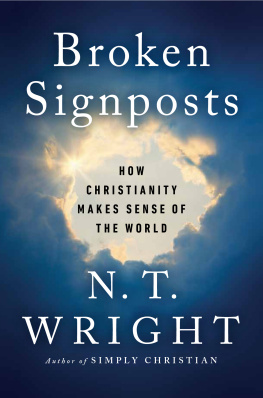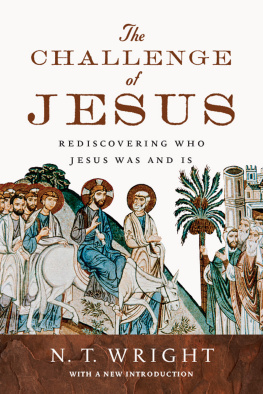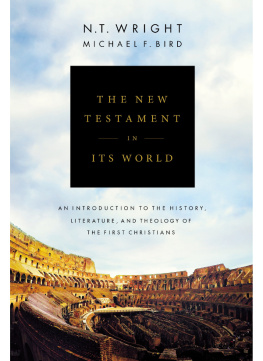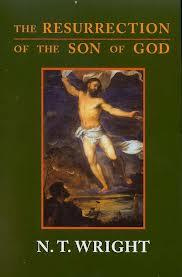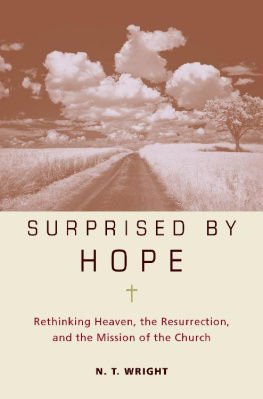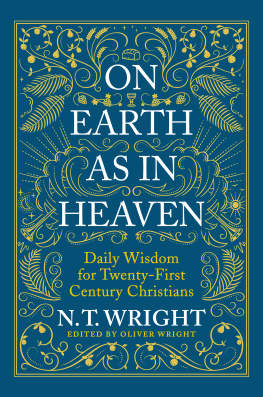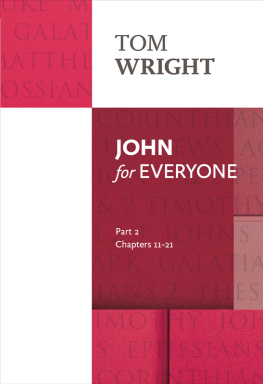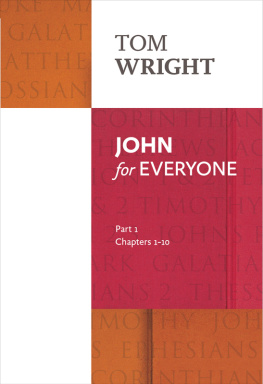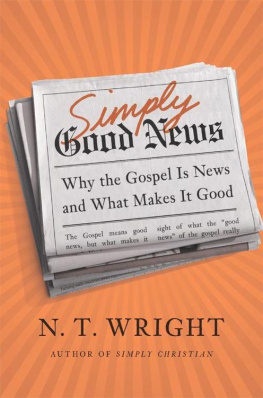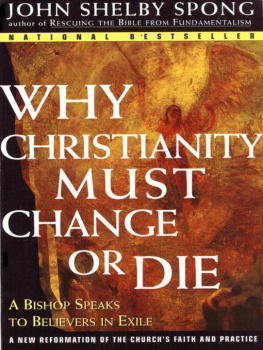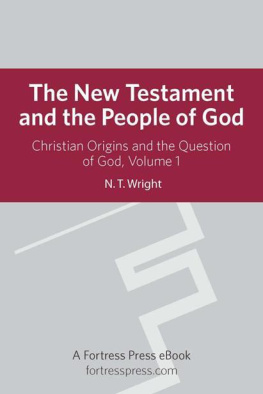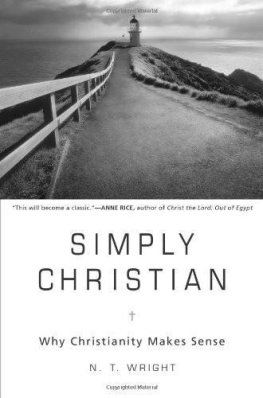S OME YEARS AGO I WROTE A PRIMER ON THE CHRISTIAN faith called Simply Christian (HarperOne, SPCK, 2005), in which I used four great themesjustice, spirituality, relationships, and beautyas the starting point. These four themes had crystallized in my mind, slowly and over some years, as I tried to think through the Christian message in relation to wider issues in human life and society.
I was at the time working in various jobs that required me to live at the tricky intersection of church and state as well as with the perennial pastors and preachers challenge of relating the real gospel to the real world. In that book I described these four as echoes of a voice: when we ponder them, its as though we are hearing someone calling to us from just around the corner, out of sight. I suggested that, though these four do not themselves necessarily point to the truth of God or of Christian faith (many people appreciate their importance without finding themselves drawn into worshipping the God revealed in Jesus), when we think through the Christian story and its meaning with these questions in mind, there is a natural fit that is more than rough coincidence.
I have reflected on these four themes a good deal since then, and as my thinking has developed, I have added three more items that we also experience as echoes of this voice: freedom, truth, and power. It now seems to me, though this would need to be argued more fully, that we need all seven to be in play if we want to work toward a wise, mature human life and society. And I have come to see these seven not simply as themes or questions, but as signposts. Signposts name a reality and point us in a direction. Likewise, these seven signposts name realities that all human cultures value as well as pointing beyond themselves to the meaning of life, to the meaning of the world. They indicate, in fact, how we ought to make sense of the worldhow we ought to understand the way the world is and the challenge of being human within it. The fact that we care about them and are puzzled by them is itself telling us something about the deep sense of the world.
But by themselves they may not tell us all we would like to know. That is why, in another more recent book, History and Eschatology: Jesus and the Promise of Natural Theology (Baylor University Press and SPCK, 2019), I describe them as broken signposts. The point there is that the seven themes do indeed appear to function as signposts that would enable us to make sense of the worldtheir constant appearance in different guises in everything from grand opera to newspaper editorials makes that clear enoughbut that they all let us down. That brokenness, however, turns out to be crucial in discerning what they really mean.
For that to make sense, though, we need to bring a different voice into the conversation. In my earlier treatment I discussed the seven broken signposts in relation to the Christian message in general. Here I want to do something quite different and invite the Gospel According to John to come on stage and address us on the topic. No doubt there are other parts of the Bible we could call on in the same way, but I have a hunch, which this book will explore, that John will provide fresh and often unexpected insight and show us the ways in which the seven themes really do function as signposts, albeit broken ones, while finally enabling us to make sense of the larger world within which they are such vital but difficult issues.
I am, as in many times past, grateful for the encouragement and editorial help I have received from Mickey Maudlin at HarperOne, and on this occasion also from Jana Reiss.
This book is dedicated to my old friend and colleague Carey C. Newman. For nearly thirty years now our paths have intertwined at both scholarly and personal levels. His friendship, encouragement, and taste in highland irrigation have been a consolation in difficult times and a delight in good ones. He would probably have wanted to edit the present book somewhat differently, but as in some other areas I presume we will continue to enjoy our disagreements as much as our many, and deep, agreements.
TOM WRIGHT
Wycliffe Hall, Oxford
Epiphany 2020
T HE FRENCH PHILOSOPHER JEAN-PAUL SARTRE ONCE suggested a definition of hell as other people. As an extrovert, I couldnt possibly agree with that statement, but in any case I have my own alternative candidate. For me, hell is the incomprehensible instructions that come with flat-pack furniture. I get down awkwardly on the floor, trying not to kneel on the smaller elements of the puzzle I have done my best to spread out in a sensible pattern. I read the instructions again. Perhaps the manufacturers put in the wrong ones?
Nothing seems to fit. Yes, here are the two sections of the wardrobe that correspond to the those in the picture on the boxwe had to buy flat-pack because our old wardrobe wouldnt go through the new bedroom doorbut where is the joining bit? How on earth do these little metal gizmos work, and how can I possibly do what the instructions say, screw them in place, without growing a third hand to hold it all together while tightening it? How can I make sense of it all?
The really annoying thing is that it looks as though it ought to work. Ive done it often enough to know the sequence of emotions. I begin with such high hopes: the picture on the box tells me that this is exactly what we need against that bedroom wall. All we have to do is to put it together! But after half an hour of struggle I feel my confidence ebbing away. Robert M. Pirsig, in his 1970s classic Zen and the Art of Motorcycle Maintenance, describes a moment like this when his hero tries, and fails, to fix something on the motorcycle. He calls it the hiss of escaping gumption. That is spot-on. We know it ought to make sense, but we cant make it do so. And the moment we admit that, morale drops dramatically. We cant understand why something that ought to fit together seems not to, and why we ourselves cant fix it, cant put it right, cant get the wardrobe together, cant (in that sense) make sense of it, literally making whatever it is into the sense that it ought to have. There may come a point when we want to throw the whole kit out the window.
Which brings us back to Jean-Paul Sartre, and to the point of this book. Human beings regularly experience the world as a whole as something that ought to make sense. There are several signs, clues if you like, of the sort of sense it ought to make. But things dont work out the way they seem to suggest.
Take two obvious examples, which we shall explore further in due course. We all know that justice matters, but even in the best systems mistakes are made, innocent people are convicted, criminals get away with it, and we start to distrust judges, juries, and the whole system. Similarly, we all know that relationships matter, but we all manage, with depressing frequency, to misunderstand one another, to hurt each other, to damage even our most important relationships, sometimes forever. That is the point where Sartre suggested throwing the whole kit out the window: life, he said, is just a sick joke.
The world promises so much, smiling alluringly, telling us how good things are going to be, but it never turns out like that, and even if it does for a while, there is a dark, mean truth to be faced soon enough that underlines Sartres skepticism. Some bold philosophers have suggested that, even if death means total annihilation, we can still make sense of the world. But for many people that seems like whistling in the dark.
So what do we say about the signposts, the features of our world that, like the picture on the flat-pack box, seem to indicate that we can and should make sense of itin both meanings: that we should be able not only to understand what life is all about (making sense of it as in understanding why things are as they are), but also to contribute creatively to it (making sense of it as in working toward fresh, creative ways forward)?

